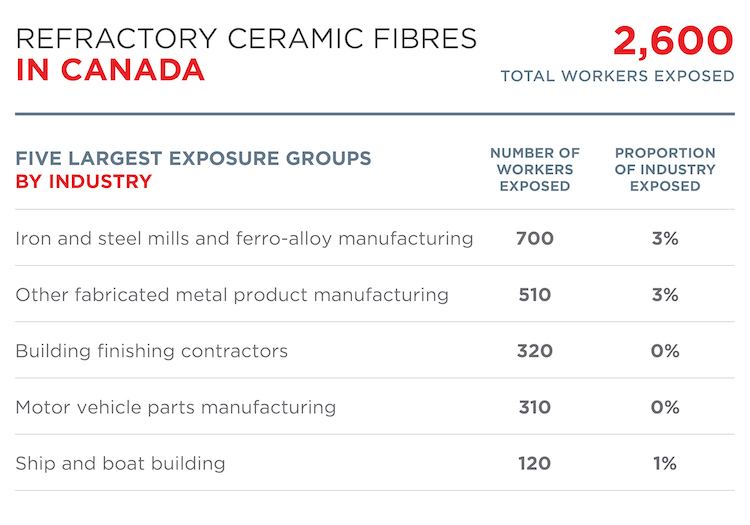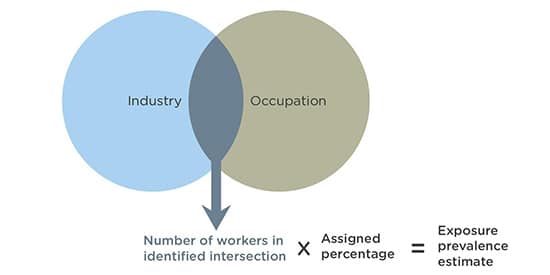Refractory Ceramic Fibres Occupational Exposures
Refractory Ceramic Fibres Occupational Exposures
Overview
Inhalation is the most important route of exposure to refractory ceramic fibres in occupational settings.[1]
CAREX Canada estimates that approximately 2,600 Canadians are exposed to RCFs in their workplaces. The largest industrial groups exposed are iron, steel, and ferro-alloy manufacturing, followed by other fabricated metal product manufacturing and building finishing contractors.
READ MORE...
Workers typically exposed to RCF are involved in manufacturing, processing, or using products and equipment containing RCFs.[1] The largest occupational groups exposed to RCF include insulators, welders and related machine operators, labourers in mineral and metal processing, and machine operators in mineral and metal processing. Other potentially exposed workers are involved in installing high-temperature insulation materials, demolition work, and maintenance and repair.[2]
Removing RCF insulating material from industrial furnaces and walls has resulted in some of the highest concentrations measured in occupational settings.[2]
Prevalence Estimate
Results show that approximately 2,600 Canadians are occupationally exposed to refractory ceramic fibres (RCF); 89% of these workers are male. Industries with the greatest numbers of exposed workers are iron, steel, and ferro-alloy manufacturing, where RCF are used as insulation for lining pipes and moulds that carry molten iron and steel, and to insulate kilns and furnaces.
When exposure is examined by occupation, the largest exposed groups are insulators (560 workers exposed), welders and related machine operators (510 workers exposed), labourers in mineral and metal processing (400 workers exposed), and machine operators in mineral and metal processing (340 workers exposed).
The number of workers exposed to refractory ceramic fibres decreased by approximately 650 workers from 2006 to 2016 (a 20% decrease). This was primarily driven by a decrease in the number of workers in the construction industry. The proportions of workers exposed to RCF were also adjusted to account for changes to the companies included in the 2013 Refractory ceramic fibre industry: environmental performance agreement overview.
Workers exposed to refractory ceramic fibres by industry in 2016

Workers exposed to refractory ceramic fibres by region in 2016
Click the second tab to view total number of workers exposed.
* = < 50 workers
Methods and Data
Our Occupational Approach page outlines the general approach used to calculate prevalence and exposure level estimates for workplace exposures.
Data Sources
Data used in developing the occupational estimates for refractory ceramic fibres (RCF) were collected from several sources:
- The Canadian Workplace Exposure Database (CWED) contains approximately 200 measurements for RCF exposure. These measurements were collected during the years 1987 to 1994 in Ontario workplaces.
- Canadian and US scientific peer reviewed publications that addressed RCF exposure in Canada and the United States.
- Grey literature including technical reports from governments and international bodies.
Prevalence Estimate Method
CAREX defines exposure to RCF as inhalation exposure at work above levels that are generally encountered in the environment.
To determine the number of workers potentially exposed to RCF at work, CAREX occupational exposure experts used methods previously established in other peer-reviewed CAREX projects in Europe. A series of steps were taken to assign exposure proportions to occupations and industries at risk of exposure to RCF.

- Occupations and industries at risk of possible exposure to RCF were identified using any combination of data sources described above.
- The total number of workers in each identified occupation and industry intersection was obtained from Statistics Canada 2016 census data.
- A percentage of workers exposed was assigned to that occupation and industry intersection. Percentages were determined by consultation with existing evidence in the data sources, previously established methods from the Europe CAREX estimates and the expert judgement of CAREX occupational hygienists.
- The number of workers in the identified group is multiplied by the assigned percentage to calculate the prevalence estimate of workers exposed to RCF.
Sources
Subscribe to our newsletters
The CAREX Canada team offers two regular newsletters: the biannual e-Bulletin summarizing information on upcoming webinars, new publications, and updates to estimates and tools; and the monthly Carcinogens in the News, a digest of media articles, government reports, and academic literature related to the carcinogens we’ve classified as important for surveillance in Canada. Sign up for one or both of these newsletters below.
CAREX Canada
School of Population and Public Health
University of British Columbia
Vancouver Campus
370A - 2206 East Mall
Vancouver, BC V6T 1Z3
CANADA
As a national organization, our work extends across borders into many Indigenous lands throughout Canada. We gratefully acknowledge that our host institution, the University of British Columbia Point Grey campus, is located on the traditional, ancestral and unceded territories of the xʷməθkʷəy̓əm (Musqueam) people.



